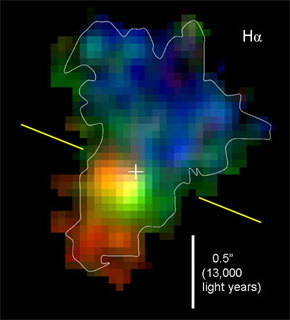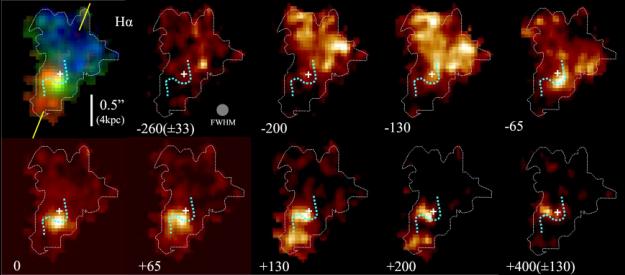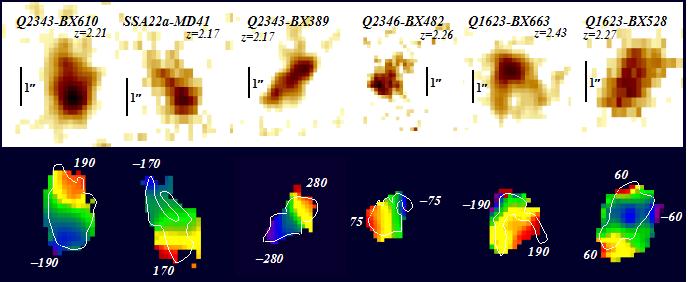
|
SINS |

|

|
SINS |

|
SINS, the Spectroscopic Imaging survey in the Near-infrared with SINFONI, is a large and coherent program to investigate in detail the dynamics and physical properties of representative samples of distant luminous galaxy populations. This on-going survey is providing new insights into the assembly and the evolution of young galaxies present in the Universe just a few billion years after the Big Bang. SINS takes advantage of the unique opportunities afforded by SINFONI at ESO's Very Large Telescope, a near-infrared integral field spectrometer combined with an adaptive optics system that delivers sharp images simultaneously with high resolution spectral information. |

Hydrogen recombination line emission of Hα of the massive star-forming galaxy BzK-15504 eleven billion light-years away (redshift z = 2.38). The observations were carried out with SINFONI in adaptive-optics mode, resulting in an angular resolution of ≈ 0.15 arcsec, or a mere 1.2 kpc (4000 light-years; indicated by the grey filled circle) at the redshift of BzK-15504. The top left panel is a color-composite map of the integrated Hα line emission, showing from blue to red the ionized gas that is blueshifted to redshifted relative to the systemic velocity of the galaxy. The other panels are channel maps showing the spatial distribution of the Hα emitting gas moving at different velocities (given in km/s) relative to the systemic velocity. |
Our finely resolved SINFONI data of BzK-15504 reveal a large
galaxy about 16 kpc (53,000 light-years) across, with several
prominent bright knots corresponding to luminous sites of active
star formation. The galaxy appears to be a disk rotating with a
maximum speed of 230 km/s, implying a large dynamical mass of
≈ 1011 Msun.
The details of the kinematics further suggest that gas is being
channeled via radial flows (outlined by the dotted line) towards a
growing central bulge, and indicate the presence of a broad and high
velocity component (bottom right panel) likely due to an outflow from
the active galactic nucleus (AGN) powered by a massive accreting black hole.
The high surface density of gas (~ 350 Msun/pc2),
the high rate of star formation (~ 150 Msun/yr),
and the moderately young stellar ages (~ 500 million years) suggest
rapid assembly, fragmentation, and conversion to stars of an initially
gas-rich protodisk.
Surprisingly, there are no obvious signs for a recent major merger
event, which would have led to the rapid mass assembly and triggerred
the intense star formation activity. This may suggest that BzK-15504
assembled its mass via smoother infall such as in the "cold flow"
accretion mechanism, or through a series of minor mergers.
BzK-15504 could later evolve into a massive elliptical galaxy.
These results appeared in
Genzel et al. 2006,
Nature, 442, 786

Spatial distribution (top row) and motions (bottom row) of the Hα line emission in six large star-forming galaxies at cosmological redshifts z ~ 2. The observations were carried out with SINFONI in seeing-limited mode, under typical seeing conditions of ≈ 0.5–0.6 arcsec, corresponding to a spatial resolution of 4–5 kpc at the redshift of the sources. The maximum velocities, relative to the systemic velocity, are given in km/s for each source. |
During the first year of the SINS survey, our SINFONI observations
revealed many large star-forming galaxies with irregular and clumpy
morphologies in Hα line emission but smooth and regular velocity
fields. For the majority of the larger systems, the ionized gas kinematics
exhibit monotonic variations across the galaxy with steepest gradient along
the geometric/kinematic major axis (e.g., the four leftmost galaxies in the
figure above) and in three of them the velocity profile flattens at large
radii.
These features are expected signatures of ordered rotation in a disk-like
structure, and provided the first convincing evidence for the existence
of large massive rotating disks at z ~ 2.
The case of BzK-15504, observed with adaptive optics but otherwise
similar in its overall properties, offers an unparalleled view into
one such system, with 3–4 times finer detail.
Interestingly, Q1623-BX663 is probably more consistent with an advanced
merger or disturbed spiral hosting an AGN responsible for the high velocity
dispersion measured at the location of the dominant Hα peak off the
center. For Q1623-BX528, the reversal in velocities along the major axis
could be indicative of a counter-rotating merger.
The discovery of so many massive rotating disks among
our SINS sample was surprising. In view of the higher rate of
major mergers at high redshift, we had expected that most of the
larger systems would exhibit more complex gas motions.
From a more detailed analysis of the best resolved cases, it appears
that their disks are quite turbulent, probably fairly gas-rich, and
likely unstable to global star formation and fragmentation. As some
simulations of the evolution of gas-rich galactic disks suggest, the
star-forming clumps could later sink towards the gravitational center
by dynamical friction to form a central bulge on a timescale of order
of 1 billion years.
This could provide a mechanism whereby some of the young disks uncovered
in the SINS survey evolve into elliptical galaxies or disk galaxies with
a dominant massive bulge, as those observed in the present-day Universe.
These results appeared in
Förster Schreiber et al. 2006,
ApJ, 645, 1062
Back to top Highlights Survey description Publications Team and collaborations Internal pages
Observations and theoretical simulations have now established a framework for galaxy formation and evolution in the young Universe. Galaxies formed as baryonic gas cooled at the center of collapsing dark matter halos, and subsequently grew through mergers and collisions leading to the hierarchical build-up of galaxy mass. It remains unclear, however, over what timescales galaxies were assembled, and when and how disks and bulges — the primary components of today's galaxies — were formed. The major limitation is our incomplete knowledge of the relevant mechanisms that control the phase, angular momentum, cooling, and dynamics of the baryonic matter.
The SINS survey now sheds new light on these issues, from
detailed information on the dynamics and physical properties
of distant luminous galaxies at early stages of evolution.
The study focusses on the crucial epochs at lookback times of
8–12 billion years ago (cosmological redshifts z ~ 1–4),
when a major fraction of the mass in stars seen in present-day
galaxies is believed to have been put in place.
Observations at near-infrared (1–2.5 μm) are well-suited to
study galaxies at z ~ 1–4 because many key diagnostic
spectral features that are present in the rest-frame optical
spectrum of galaxies are redshifted in the near-infrared bands.
This includes important emission lines from ionized gas tracing
the sites of intense star-formation activity or shock-excited
material (such as the hydrogen Balmer recombination lines of
Hα and Hβ, and the forbidden lines from atomic
fine-structure transitions of [NII],
[OIII], [OII],
[SII]).
Until only recently, spatially-resolved information of such key
spectral diagnostics were virtually non-existent. This has now
changed with the
SINFONI
instrument mounted at the
ESO
Very Large Telescope.
SINFONI consists of
SPIFFI
(built by the IR/submm group at MPE),
a cryogenic near-infrared integral field spectrometer that provides
the spectrum of a full atmospheric band simultaneously at all positions
over the entire square field of view.
SPIFFI is coupled to a curvature-sensing adaptive optics (AO) module,
MACAO
(built by ESO),
which can be used with a natural or laser guide star and enable
diffraction-limited observations at the VLT 8-m telescope.
The unique capabilities afforded by SINFONI make it possible to fully map the relative motions and spatial distribution of the gas and stars within distant galaxies, and to relate directly spatial variations in the kinematics and physical properties with morphological features. To obtain a panoramic view of the properties of high redshift galaxies, we draw our SINS targets from samples selected by a variety of methods based on integrated colours and luminosities (for instance, "BM/BX" and "BzK" objects at z ~ 2, Lyman-break galaxies at z ~ 3, and K- and submillimeter-bright galaxies at z ~ 1.5–3.5). More specifically, we use SINFONI to:
The SINS survey is an on-going effort as further SINFONI data are collected to expand the current samples. To analyze the data and interpret the results, large efforts are now dedicated into the development and application of sophisticated analysis tools, theoretical modeling, and comparisons to simulations of the formation and evolution of galaxies. These include:
Back to top Highlights Survey description Publications Team and collaborations Internal pages
|
|
ESO Press Release | MPG Press Release (German) |
|
Förster Schreiber, N. M., et al. 2006, ApJ, 645, 1062 |
|
|
Genzel, R., et al. 2006, Nature, 442, 786 |
|
|
Nesvadba, N., et al. 2006, ApJ, in press (astro-ph/0611769) |
|
|
Nesvadba, N., et al. 2006, ApJ, 650, 693 |
|
|
Nesvadba, N., et al. 2006, ApJ, 650, 661 |
|
|
Tecza, M., et al. 2004, ApJ, 605, L109 |
|
Förster Schreiber, N.M., et al. 2006, The Messenger, 125, 11 |
|
|
Eisenhauer, F., et al. 2003, The Messenger, 113, 17 |
|
|
Bonnet, H., et al. 2004, The Messenger, 117, 17 |
Back to top Highlights Survey description Publications Team and collaborations Internal pages
N.M. Förster Schreiber, R. Genzel, N. Bouché,
F. Eisenhauer, L. J. Tacconi, R. Davies,
G. Cresci, S. Genel, D. Lutz, P. Buschkamp,
S. Gillessen, E. K. Strobel Hicks (all at MPE),
M. D. Lehnert (Meudon), N.P.H. Nesvadba (Meudon),
K. Shapiro (Berkeley), A. Sternberg (Tel Aviv),
A. Verma (Oxford), R. Abuter (ESO).
A. Cimatti (Bologna), E. Daddi (Saclay), A. Renzini (Padova),
X. Kong (Heifei), N. Arimoto (Tokyo), M. Mignoli (Bologna),
D. Erb (Harvard), A. E. Shapley (Princeton), C. C. Steidel (Caltech),
T. Naab and A. Burkert (USM München).
Back to top Highlights Survey description Publications Team and collaborations Internal pages